Global Animal PCR Diagnostics Market, By Product Type, By Animal Type, By Technologies, By Application, By End User, By Region & Segmental Insights Trends and Forecast, 2024 – 2034
- Industry: Healthcare
- Report ID: TNR-110-1197
- Number of Pages: 420
- Table/Charts : Yes
- July, 2024
- Base Year : 2024
- No. of Companies : 10+
- No. of Countries : 29
- Views : 10135
- Covid Impact Covered: Yes
- War Impact Covered: Yes
- Formats : PDF, Excel, PPT
In Terms of Revenue, the Global Animal PCR Diagnostics Market was Worth US$ 191.5 Mn in 2023 and is Anticipated to Witness a CAGR of 7.2% During 2024 – 2034. Animal PCR diagnostics refers to the use of polymerase chain reaction (PCR) technology for detecting and analyzing genetic material in animals. This market is poised for significant growth, driven by the increasing awareness of animal health, rising pet ownership, and the expanding livestock industry. The market is characterized by several trends, including the adoption of advanced technologies like quantitative real-time PCR (qPCR) and digital PCR (dPCR), which offer high sensitivity and specificity. There is a growing demand for point-of-care diagnostics, which provide rapid and accurate results, facilitating timely treatment.
Opportunities abound in this market, particularly in the development of novel diagnostic kits and reagents, the expansion of diagnostic services, and the integration of PCR diagnostics with other technologies such as next-generation sequencing (NGS). Growth drivers include the increasing prevalence of zoonotic diseases, the need for early and accurate diagnosis of infectious diseases, and the rising investments in veterinary healthcare infrastructure. These factors are expected to propel the market forward, creating lucrative opportunities for stakeholders.

Animal PCR Diagnostics Market Dynamic
Growth Driver-
Increasing Prevalence of Zoonotic Diseases
The increasing prevalence of zoonotic diseases and the rising need for early and accurate disease detection are primary drivers. Advances in PCR technology, such as quantitative real-time PCR (qPCR) and digital PCR (dPCR), enhance the sensitivity and specificity of diagnostics, fueling market expansion. Growing pet ownership and heightened awareness of animal health among pet owners contribute to the demand for advanced diagnostic tools. The expanding livestock industry also necessitates robust disease management solutions. Increased investments in veterinary healthcare infrastructure and ongoing research and development activities further support the market’s growth, creating significant opportunities for innovation and expansion.
Trends-
Adoption of Advanced Technologies
The adoption of advanced technologies such as quantitative real-time PCR (qPCR) and digital PCR (dPCR) is increasing, driven by their high sensitivity and accuracy. There’s a growing demand for point-of-care diagnostic solutions, which offer rapid and reliable results, essential for timely intervention. Integration of PCR diagnostics with next-generation sequencing (NGS) is another emerging trend, enhancing the precision of genetic analysis. Additionally, the market is seeing a rise in the development of multiplex PCR assays, allowing simultaneous detection of multiple pathogens. These trends, combined with ongoing advancements in PCR technology and increasing awareness of animal health, are shaping the future of the market.
Challenge-
High Costs Associated with PCR Equipment and Reagents
High costs associated with PCR equipment and reagents can be prohibitive, particularly for smaller veterinary practices and developing regions. The need for specialized technical expertise to operate PCR instruments and interpret results can limit widespread adoption. Additionally, regulatory complexities and stringent approval processes for new diagnostic tests can slow market entry for innovative products. Variability in sample quality and preparation can also impact the accuracy and reliability of PCR diagnostics. Competition from alternative diagnostic methods, such as immunoassays, poses a challenge. Addressing these issues requires investment in cost-effective technologies, training programs, and streamlined regulatory pathways to enhance the accessibility and efficiency of PCR diagnostics in veterinary medicine.
Animal PCR Diagnostics Market Segmentation by Product Type, Animal Type, Technologies, Application, End User, Region
Reagents and consumables segment is set to dominate the animal PCR diagnostics market, commanding a substantial revenue share of 59.2% over the forecast period. This dominance is attributed to the recurring need for these products in every PCR test, which includes primers, probes, nucleotides, and enzymes. The continuous demand for high-quality reagents and consumables ensures consistent market growth, driven by the increasing frequency of PCR testing in veterinary diagnostics. Advancements in reagent formulations and the introduction of specialized kits for specific pathogens are further propelling this segment. The critical role of reagents and consumables in ensuring the accuracy and reliability of PCR results underscores their significant revenue contribution to the market.
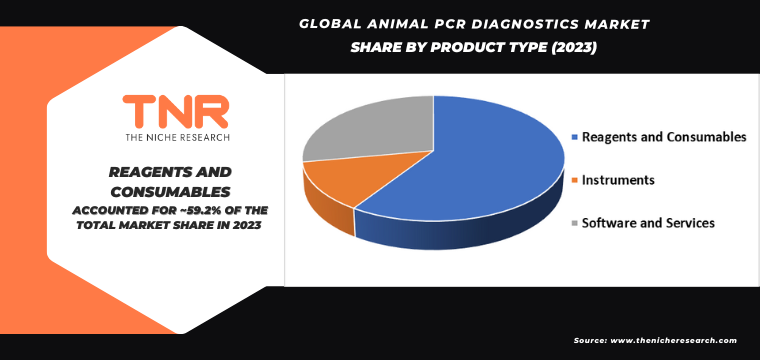
Companion animals is anticipated to be the fastest-growing animal type segment in the animal PCR diagnostics market, capturing a substantial revenue share of 32.6% over the forecast period. This growth is driven by the rising pet ownership worldwide, increased spending on pet healthcare, and growing awareness of the importance of early and accurate disease diagnosis. Advances in PCR technology are making it easier to detect and monitor a wide range of infectious diseases and genetic disorders in pets. The humanization of pets, where pets are increasingly considered family members, is boosting demand for advanced diagnostic tools. Veterinary clinics and pet owners are thus investing more in PCR diagnostics to ensure the health and well-being of companion animals.
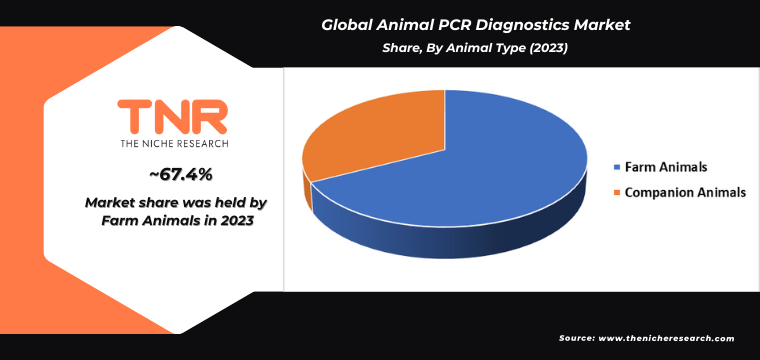
Quantitative real-time PCR (qPCR) segment by technology dominated the animal PCR diagnostics market, capturing a significant revenue share of 30.8% over the forecast period. This dominance is due to qPCR’s ability to provide highly sensitive, specific, and quantitative results, making it a preferred choice for detecting and quantifying pathogens in animal diagnostics. Its widespread adoption is driven by the need for accurate disease detection and monitoring in both companion and livestock animals. The technology’s rapid turnaround time and ability to detect multiple pathogens simultaneously enhance its utility in veterinary practices. Continuous advancements in qPCR technology, including the development of multiplex assays and improved reagents, are further bolstering its market position.
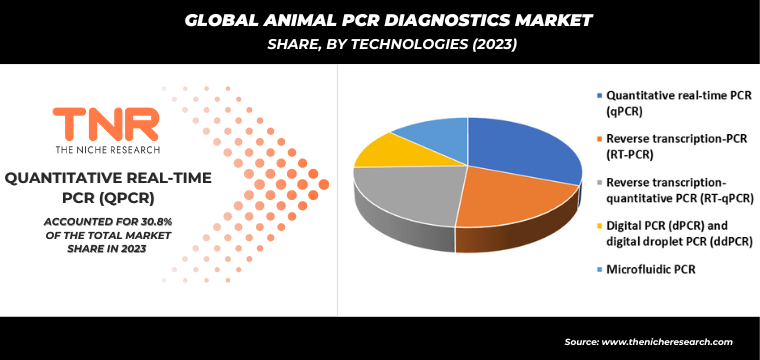
Genetic testing is anticipated to be the second fastest-growing application segment in the animal PCR diagnostics market, capturing a substantial revenue share of 23.4% over the forecast period. This growth is driven by the increasing demand for genetic screening to identify hereditary conditions, breed characteristics, and potential genetic disorders in both companion and livestock animals. Advances in PCR technology have made genetic testing more accessible and accurate, enabling early diagnosis and intervention. The rising awareness among pet owners and breeders about the benefits of genetic testing further propels this segment. Additionally, the livestock industry’s focus on improving breeding programs and animal health management contributes to the significant growth of genetic testing applications in the market.
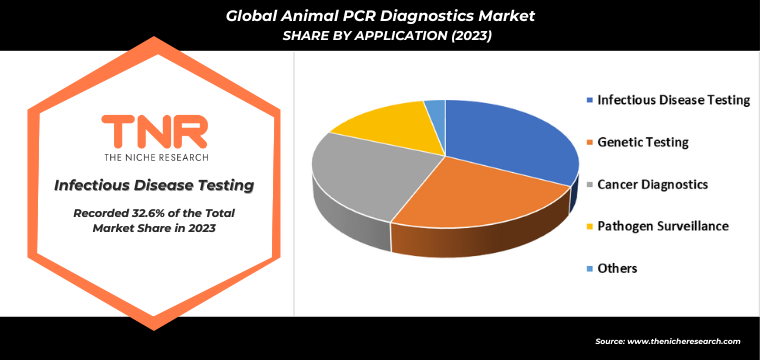
Veterinary diagnostic centers segment by end user dominated the animal PCR diagnostics market, capturing a significant revenue share of 45.6% over the forecast period.
This dominance is driven by the increasing reliance of veterinary professionals on advanced diagnostic tools like PCR to accurately diagnose and monitor diseases in animals. Veterinary diagnostic centers play a pivotal role in providing comprehensive diagnostic services, offering a wide range of PCR tests for infectious diseases, genetic disorders, and other health conditions in both companion animals and livestock.
The ability of these centers to perform rapid, on-site PCR testing enhances treatment decisions and patient care outcomes, fostering greater adoption among veterinarians and pet owners alike. Continued investment in veterinary healthcare infrastructure and technological advancements further support the growth of this segment in the market.
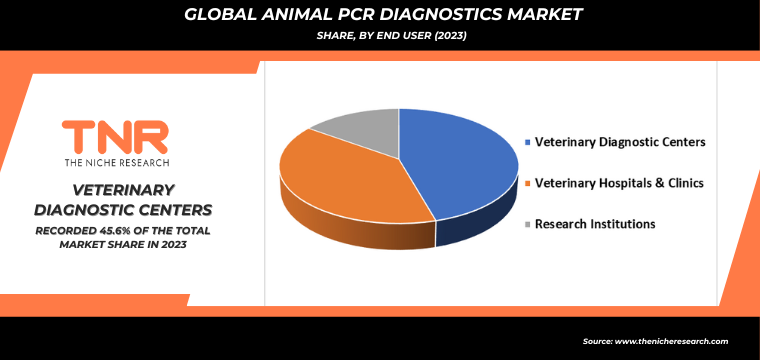
In 2023, Asia Pacific is anticipated to play a significant role in propelling the growth of the animal PCR diagnostics market, contributing approximately 28.9% to its overall expansion.
This region’s pivotal role is driven by several factors, including the rising pet ownership rates, increasing demand for livestock health management solutions, and expanding veterinary healthcare infrastructure. Countries like China, India, Japan, and Australia are witnessing rapid urbanization, leading to higher awareness and expenditure on animal health.
Government initiatives aimed at improving animal disease surveillance and enhancing food safety standards are bolstering market growth. The adoption of advanced PCR technologies in veterinary diagnostics is also gaining momentum across Asia Pacific, driven by the need for accurate and timely disease diagnosis in both companion animals and livestock, thereby fueling market expansion in the region.
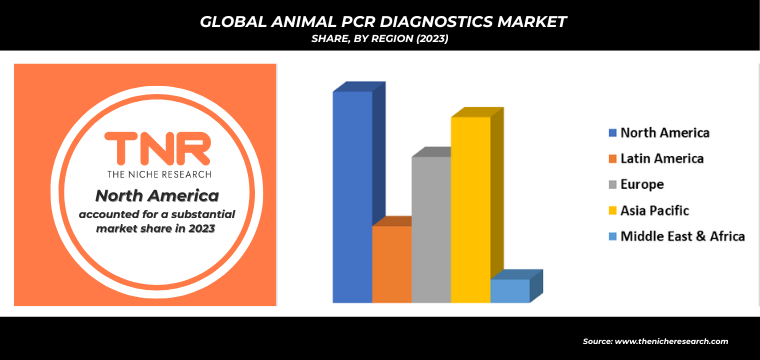
Key Developments
- In September 2022, Zoetis Inc. acquired Jurox, an animal health company specializing in the development, production, and marketing of a wide range of veterinary pharmaceuticals for livestock and companion animals. Jurox is headquartered in Australia and has regional offices in New Zealand, the United States, Canada, and the United Kingdom.
- In September 2022, Zomedica, a veterinary health company focused on developing innovative diagnostic and therapeutic solutions for companion animals, announced the commercial launch of its latest assay, Free T4 (fT4), for the TRUFORMA In-Clinic Biosensor Testing Platform.
Major Players in Animal PCR Diagnostics Market
- BIOMÉRIEUX
- Bioneer Corporation
- Bio-Rad Laboratories, Inc.
- Eurolyser Diagnostica GmbH
- IDEXX Laboratories
- INDICAL BIOSCIENCE GmbH
- MEGACOR Diagnostik GmbH
- Neogen Corporation
- Thermo Fisher Scientific Inc.
- Zoetis
- Other Industry Participants
Global Animal PCR Diagnostics Market Scope
| Report Specifications | Details |
| Market Revenue in 2023 | US$ 191.5 Mn |
| Market Size Forecast by 2034 | US$ 411.3 Mn |
| Growth Rate (CAGR) | 7.2% |
| Historic Data | 2016 – 2022 |
| Base Year for Estimation | 2023 |
| Forecast Period | 2024 – 2034 |
| Report Inclusions | Market Size & Estimates, Market Dynamics, Competitive Scenario, Trends, Growth Factors, Market Determinants, Key Investment Segmentation, Product/Service/Solutions Benchmarking |
| Segments Covered | By Product Type, By Animal Type, By Technologies, By Application, By End User, By Region |
| Regions Covered | North America, Europe, Asia Pacific, Middle East & Africa, Latin America |
| Countries Covered | U.S., Canada, Mexico, Rest of North America, France, The UK, Spain, Germany, Italy, Nordic Countries (Denmark, Finland, Iceland, Sweden, Norway), Benelux Union (Belgium, The Netherlands, Luxembourg), Rest of Europe, China, Japan, India, New Zealand, Australia, South Korea, Southeast Asia (Indonesia, Thailand, Malaysia, Singapore, Rest of Southeast Asia), Rest of Asia Pacific, Saudi Arabia, UAE, Egypt, Kuwait, South Africa, Rest of Middle East & Africa, Brazil, Argentina, Rest of Latin America |
| Key Players | BIOMÉRIEUX, Bioneer Corporation, Bio-Rad Laboratories, Inc., Eurolyser Diagnostica GmbH, IDEXX Laboratories, INDICAL BIOSCIENCE GmbH, MEGACOR Diagnostik GmbH, Neogen Corporation, Thermo Fisher Scientific Inc., Zoetis |
| Customization Scope | Customization allows for the inclusion/modification of content pertaining to geographical regions, countries, and specific market segments. |
| Pricing & Procurement Options | Explore purchase options tailored to your specific research requirements |
| Contact Details | Consult With Our Expert
Japan (Toll-Free): +81 663-386-8111 South Korea (Toll-Free): +82-808- 703-126 Saudi Arabia (Toll-Free): +966 800-850-1643 United Kingdom: +44 753-710-5080 United States: +1 302-232-5106 E-mail: askanexpert@thenicheresearch.com
|
Global Animal PCR Diagnostics Market
By Product Type
- Reagents and Consumables
- Instruments
- Software and Services
By Animal Type
- Farm Animals
- Cattle
- Poultry
- Swine
- Horses
- Other Farm Animals
- Companion Animals
- Dogs
- Cats
- Others
By Technologies
- Quantitative real-time PCR (qPCR)
- Reverse transcription-PCR (RT-PCR)
- Reverse transcription-quantitative PCR (RT-qPCR)
- Digital PCR (dPCR) and digital droplet PCR (ddPCR)
- Microfluidic PCR
By Application
- Infectious Disease Testing
- Genetic Testing
- Cancer Diagnostics
- Pathogen Surveillance
- Others
By End User
- Veterinary Diagnostic Centers
- Veterinary Hospitals & Clinics
- Research Institutions
By Region
- North America (U.S., Canada, Mexico, Rest of North America)
- Europe (France, The UK, Spain, Germany, Italy, Nordic Countries (Denmark, Finland, Iceland, Sweden, Norway), Benelux Union (Belgium, The Netherlands, Luxembourg), Rest of Europe)
- Asia Pacific (China, Japan, India, New Zealand, Australia, South Korea, Southeast Asia (Indonesia, Thailand, Malaysia, Singapore, Rest of Southeast Asia), Rest of Asia Pacific)
- Middle East & Africa (Saudi Arabia, UAE, Egypt, Kuwait, South Africa, Rest of Middle East & Africa)
- Latin America (Brazil, Argentina, Rest of Latin America)
Report Layout:
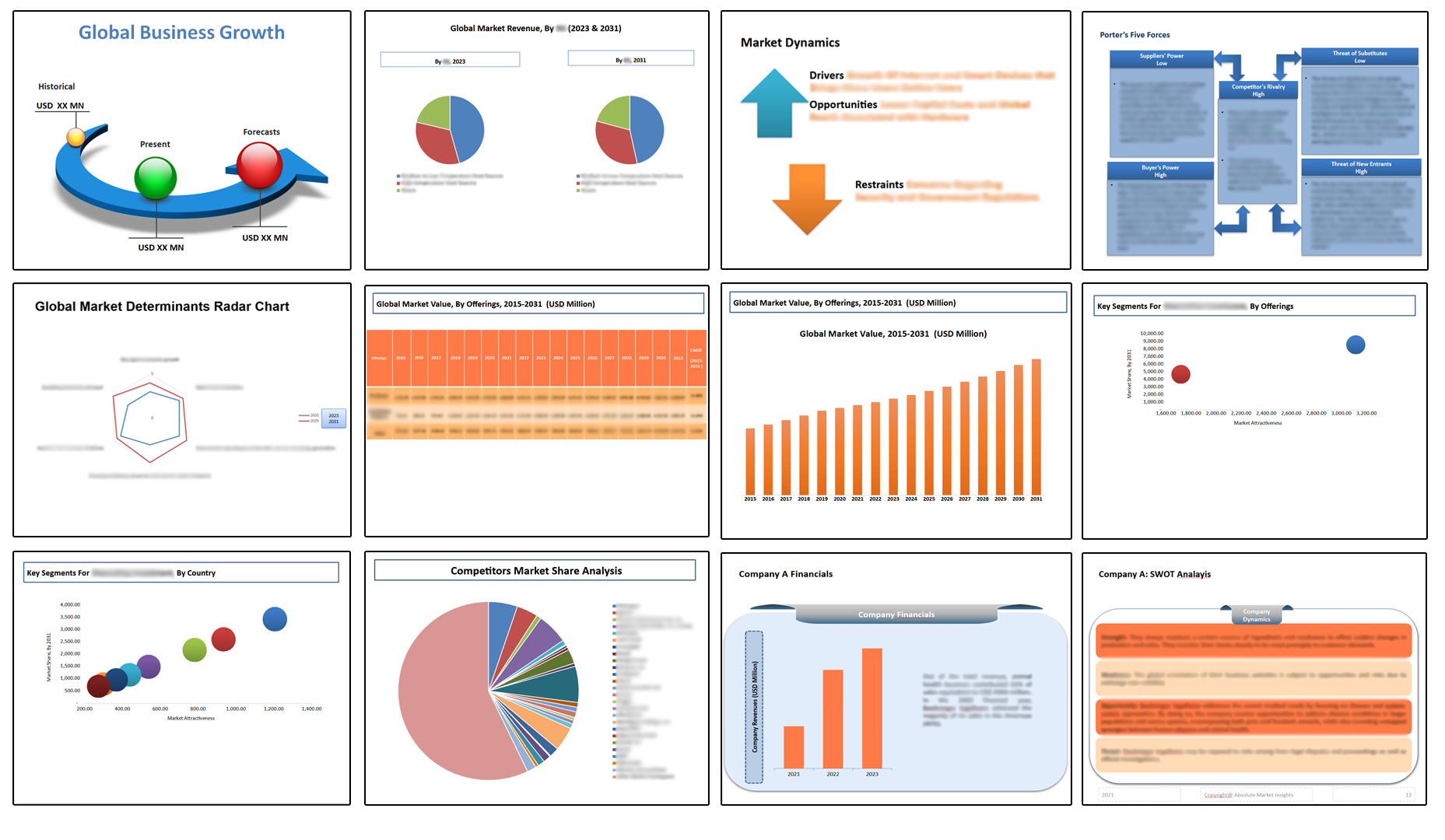
Table of Contents
Note: This ToC is tentative and can be changed according to the research study conducted during the course of report completion.
**Exclusive for Multi-User and Enterprise User.
Global Animal PCR Diagnostics Market
By Product Type
- Reagents and Consumables
- Instruments
- Software and Services
By Animal Type
- Farm Animals
- Cattle
- Poultry
- Swine
- Horses
- Other Farm Animals
- Companion Animals
- Dogs
- Cats
- Others
By Technologies
- Quantitative real-time PCR (qPCR)
- Reverse transcription-PCR (RT-PCR)
- Reverse transcription-quantitative PCR (RT-qPCR)
- Digital PCR (dPCR) and digital droplet PCR (ddPCR)
- Microfluidic PCR
By Application
- Infectious Disease Testing
- Genetic Testing
- Cancer Diagnostics
- Pathogen Surveillance
- Others
By End User
- Veterinary Diagnostic Centers
- Veterinary Hospitals & Clinics
- Research Institutions
By Region
- North America (U.S., Canada, Mexico, Rest of North America)
- Europe (France, The UK, Spain, Germany, Italy, Nordic Countries (Denmark, Finland, Iceland, Sweden, Norway), Benelux Union (Belgium, The Netherlands, Luxembourg), Rest of Europe)
- Asia Pacific (China, Japan, India, New Zealand, Australia, South Korea, Southeast Asia (Indonesia, Thailand, Malaysia, Singapore, Rest of Southeast Asia), Rest of Asia Pacific)
- Middle East & Africa (Saudi Arabia, UAE, Egypt, Kuwait, South Africa, Rest of Middle East & Africa)
- Latin America (Brazil, Argentina, Rest of Latin America)
The Niche Research approach encompasses both primary and secondary research methods to provide comprehensive insights. While primary research is the cornerstone of our studies, we also incorporate secondary research sources such as company annual reports, premium industry databases, press releases, industry journals, and white papers.
Within our primary research, we actively engage with various industry stakeholders, conducting paid interviews and surveys. Our meticulous analysis extends to every market participant in major countries, allowing us to thoroughly examine their portfolios, calculate market shares, and segment revenues.
Our data collection primarily focuses on individual countries within our research scope, enabling us to estimate regional market sizes. Typically, we employ a bottom-up approach, meticulously tracking trends in different countries. We analyze growth drivers, constraints, technological innovations, and opportunities for each country, ultimately arriving at regional figures.Our process begins by examining the growth prospects of each country. Building upon these insights, we project growth and trends for the entire region. Finally, we utilize our proprietary model to refine estimations and forecasts.
Our data validation standards are integral to ensuring the reliability and accuracy of our research findings. Here’s a breakdown of our data validation processes and the stakeholders we engage with during our primary research:
- Supply Side Analysis: We initiate a supply side analysis by directly contacting market participants, through telephonic interviews and questionnaires containing both open-ended and close-ended questions. We gather information on their portfolios, segment revenues, developments, and growth strategies.
- Demand Side Analysis: To gain insights into adoption trends and consumer preferences, we reach out to target customers and users (non-vendors). This information forms a vital part of the qualitative analysis section of our reports, covering market dynamics, adoption trends, consumer behavior, spending patterns, and other related aspects.
- Consultant Insights: We tap into the expertise of our partner consultants from around the world to obtain their unique viewpoints and perspectives. Their insights contribute to a well-rounded understanding of the markets under investigation.
- In-House Validation: To ensure data accuracy and reliability, we conduct cross-validation of data points and information through our in-house team of consultants and utilize advanced data modeling tools for thorough verification.
The forecasts we provide are based on a comprehensive assessment of various factors, including:
- Market Trends and Past Performance (Last Five Years): We accurately analyze market trends and performance data from preceding five years to identify historical patterns and understand the market’s evolution.
- Historical Performance and Growth of Market Participants: We assess the historical performance and growth trajectories of key market participants. This analysis provides insights into the competitive landscape and individual company strategies.
- Market Determinants Impact Analysis (Next Eight Years): We conduct a rigorous analysis of the factors that are projected to influence the market over the next eight years. This includes assessing both internal and external determinants that can shape market dynamics.
- Drivers and Challenges for the Forecast Period:Identify the factors expected to drive market growth during the forecast period, as well as the challenges that the industry may face. This analysis aids in deriving an accurate growth rate projection.
- New Acquisitions, Collaborations, or Partnerships: We keep a close watch on any new acquisitions, collaborations, or partnerships within the industry. These developments can have a significant impact on market dynamics and competitiveness.
- Macro and Micro Factors Analysis:A thorough examination of both macro-level factors (e.g., economic trends, regulatory changes) and micro-level factors (e.g., technological advancements, consumer preferences) that may influence the market during the forecast period.
- End-User Sentiment Analysis: To understand the market from the end-user perspective, we conduct sentiment analysis. This involves assessing the sentiment, preferences, and feedback of the end-users, which can provide valuable insights into market trends.
- Perspective of Primary Participants: Insights gathered directly from primary research participants play a crucial role in shaping our forecasts. Their perspectives and experiences provide valuable qualitative data.
- Year-on-Year Growth Trend: We utilize a year-on-year growth trend based on historical market growth and expected future trends. This helps in formulating our growth projections, aligning them with the market’s historical performance.
Research process adopted by TNR involves multiple stages, including data collection, validation, quality checks, and presentation. It’s crucial that the data and information we provide add value to your existing market understanding and expertise. We have also established partnerships with business consulting, research, and survey organizations across regions and globally to collaborate on regional analysis and data validation, ensuring the highest level of accuracy and reliability in our reports.









